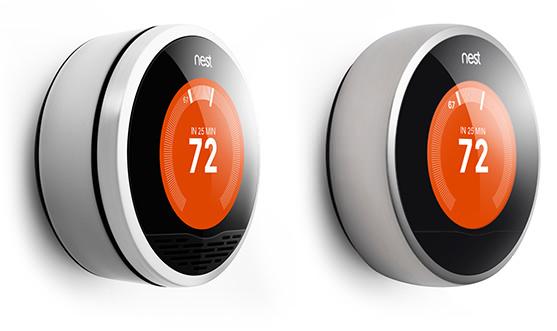Former Apple executive Tony Fadell on Tuesday introduced the second iteration of his company's Nest Learning Thermostat, touting a 20 percent size reduction and enhanced heating and cooling functions. Original Nest (left) compared to second-generation unit.
In a post to Nest's blog, Fadell detailed the second-generation thermostat's features such as new hardware and software, wider compatibility, more apps and a refreshed design. Along with the device's debut, the company is rolling out version 3.0 of its Nest software for existing owners.
As far as hardware is concerned, the second-generation Nest brings a revamped wiring layout with compatibility for two stage cooling and dual fuel systems, emergency heat, and whole-home humidifiers and dehumidifiers. The unit's face is now a one-piece "lens," doing away with the original device's sensor grill.
Carried over from the first-generation product is Wi-Fi connectivity, programmable functions based on usage patterns and remote control over wireless via supported apps.
Just as in the first version, Fadell, also known as the "grandfather of the iPod," designed the new Nest with an aluminum enclosure and easy-to-use interface.
The second-generation Nest Learning Thermostat comes in at $249 and is available for pre-order through the company's online store.
 AppleInsider Staff
AppleInsider Staff








 Charles Martin
Charles Martin

 Malcolm Owen
Malcolm Owen
 William Gallagher
William Gallagher
 Christine McKee
Christine McKee
 Marko Zivkovic
Marko Zivkovic
 Mike Wuerthele
Mike Wuerthele










20 Comments
Who cares?
Honeywell Prestige 2.0 is much easier to use and is far more functional and capable (apart from lacking motion detection) than Nest 1 or 2. For instance, temperature and humidity readings are provided both indoors and outdoors at your house (not just somewhere in your zip code), multiple wireless remote temperature+humidity sensors can be configured around the house, humidity can be regulated by an optional dehumidifier or existing AC, and the Honeywell color touch panel interface is much easier to use. The Honeywell smartphone app and web interfaces also provide far more control over the thermostat and are super well-designed and easy-to-use. The Honeywell can optionally circulate the air periodically even if heating or cooling isn't needed. The Honeywell isn't any more difficult to install than a regular thermostat either, even though Honeywell would like customers to hire a professional for the job.
The Nest motion detection did essentially nothing for us--except cause trouble with its dumb learning--because our house is somewhat large and the thermostat's location is rarely visited by anyone. The Nest only needs 4 wires--but so does the Honeywell if you get the ~$20 "wiresaver" module. And with the Nest, if you have a furnace and A/C and only 4 wires, the fan must be run periodically (wasting energy) in order to charge the Nest battery if no heating or cooling are needed for an extended period of time. The Nest smartphone app is not only limited in function but surprisingly poorly designed.
If you've been invested in AAPL for a few years, you can probably afford the best... and that ain't Nest.
As with much in tech, very glad I waited and didn't grab a first-gen before we really needed it. It'll only get thinner, it'll only get cheaper, it'll only get better.
Who cares?
You posted. You do. And since you didn't give any explanation as to why you wouldn't, the negative can't even be assumed.
It's too expensive. 3M-50 is just $99 and does its job very well.
A report was posted on CNN claiming the Nest was causing home owners pets to react adversely and run into the walls randomly. When investigated the Nest was reported to be transmitting a intermittent high pitch sound not detectable by human ears. The owner was quoted as saying "One should chose better pets."